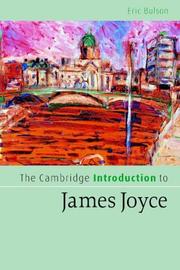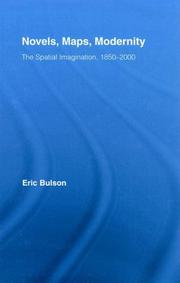| Listing 1 - 10 of 10 |
Sort by
|

ISBN: 9780521549653 9780521840378 0521549655 9780511607301 0511242948 9780511242946 0511244444 9780511244445 051124519X 9780511245190 9780511648625 0511648626 051160730X 9780511438899 0511438893 0521840376 1107162750 0511567294 Year: 2006 Publisher: Cambridge ; New York : Cambridge University Press,
Abstract | Keywords | Export | Availability | Bookmark
 Loading...
Loading...Choose an application
- Reference Manager
- EndNote
- RefWorks (Direct export to RefWorks)
James Joyce has a reputation for being one of modern literature's most difficult writers. This introduction gives students the necessary tools they will need to get the most out of reading him. It provides the essential biographical information and situates his life and works in broader cultural, historical, and literary contexts. Students will also find detailed examinations of the major works including Ulysses and Finnegans Wake. In addition, Bulson lets students see how Joyce evolved as a writer. This introduction also provides a brief history of the critical reception of Joyce's life and works and explains what a variety of critical approaches can teach us. A guide to further reading has been included for those interested in consulting some of the more influential secondary works. This accessible and lively introduction gives students everything they will need to get started reading, understanding, and appreciating Joyce.
Joyce, James Augustine Aloysius, --- Joyce, James, --- Criticism and interpretation --- 820 "19" JOYCE, JAMES --- 820 "19" JOYCE, JAMES Engelse literatuur--20e eeuw. Periode 1900-1999--JOYCE, JAMES --- Engelse literatuur--20e eeuw. Periode 1900-1999--JOYCE, JAMES --- Criticism and interpretation. --- Joyce, James --- Joyce, James Augustine Aloysius --- Dzhoĭs, Dzheĭms Avgustin Aloiziĭ --- Džoiss, Džeimss --- Gʻois, Gʻaims --- Joyce, Giacomo --- Jūyis, Jīms --- Tzoys, Tzaiēms --- Tzoys, Tzeēms --- Джойс, Джеймс --- Джойс, Джеймс Августин Алоїсуїс --- Zhoĭs, Zheĭms --- ג׳ויס, ג׳ײמס, --- ג׳ויס, ג׳יימס, --- ジョイス --- ジェームスジョイス, --- Authors, Irish --- Irish authors --- Arts and Humanities --- Literature --- Joyce, James, - 1882-1941 --- Joyce, James, - 1882-1941 - Criticism and interpretation --- Joyce, James Augustine Aloysius, 1882-1941
Book
ISBN: 9781316609774 9781107156210 1107156211 1316609774 9781316659694 Year: 2018 Publisher: Cambridge, United Kingdom ; New York, NY : Cambridge University Press,
Abstract | Keywords | Export | Availability | Bookmark
 Loading...
Loading...Choose an application
- Reference Manager
- EndNote
- RefWorks (Direct export to RefWorks)
Eric Bulson "The novel is sogged with humanity." E.M. Forster I "His studies are not very deep," one character says about another in George Eliot's Middlemarch, "he is only reading a novel." Just imagine if that same critical judgement about novels and novel readers were accurate today! Not only would it be assumed that we all read novels merely to pass the time, but also with the assumption that they don't have much to teach us in the first place. We'd only be reading a novel, and that's it. The real knowledge about life and living, we'd be told, lies elsewhere, maybe in the great epics of bygone ages, intensely private lyric poems, or sweeping dramas where all the world's a stage. The novel, of course, still has its detractors, but no one can deny that this literary genre runs "very deep." Part of that depth comes from the fact that the novel, a term ironically rooted in the Latin word for new (novum), is actually rather old. In fact, by some accounts it goes back 4,000 years to the narrative fictions of ancient Egypt with examples appearing subsequently as far afield as Hellenistic Greece, the histories and romances of medieval China and France, and the subgenres of modern England, Russia, Brazil, Nigeria, Japan, and the United States. And if the forms of the novel are indeed many, they are evidence enough that there has been an ongoing desire across cultures and over millenia to tell fictional stories in prose about life.
Roman --- Histoire et critique --- Fiction --- History and criticism --- Histoire et critique.
Book
ISBN: 0231542321 9780231542326 9780231179768 0231179766 Year: 2017 Publisher: New York : Columbia University Press,
Abstract | Keywords | Export | Availability | Bookmark
 Loading...
Loading...Choose an application
- Reference Manager
- EndNote
- RefWorks (Direct export to RefWorks)
Little magazines made modernism. These unconventional, noncommercial publications may have brought writers such as James Joyce, T. S. Eliot, Ezra Pound, Marianne Moore, Mina Loy, and Wallace Stevens to the world but, as Eric Bulson shows in Little Magazine, World Form, their reach and importance extended far beyond Europe and the United States. By investigating the global and transnational itineraries of the little-magazine form, Bulson uncovers a worldwide network that influenced the development of literature and criticism in Africa, the West Indies, the Pacific Rim, and South America.In addition to identifying how these circulations and exchanges worked, Bulson also addresses equally formative moments of disconnection and immobility. British and American writers who fled to Europe to escape Anglo-American provincialism, refugees from fascism, wandering surrealists, and displaced communists all contributed to the proliferation of print. Yet the little magazine was equally crucial to literary production and consumption in the postcolonial world, where it helped connect newly independent African nations. Bulson concludes with reflections on the digitization of these defunct little magazines and what it means for our ongoing desire to understand modernism's global dimensions in the past and its digital afterlife.
Little magazines --- Literature and society --- Modernism (Literature) --- Crepuscolarismo --- Literary movements --- Literature --- Literature and sociology --- Society and literature --- Sociology and literature --- Sociolinguistics --- Small magazines --- Periodicals --- History --- Social aspects --- Sociology of literature --- Modernism (Literature).
Book
ISBN: 0231546475 0231186045 Year: 2020 Publisher: New York : Columbia University Press,
Abstract | Keywords | Export | Availability | Bookmark
 Loading...
Loading...Choose an application
- Reference Manager
- EndNote
- RefWorks (Direct export to RefWorks)
Ulysses has been read obsessively for a century. What if instead of focusing on the words to understand the structure, design, and history of Joyce’s masterpiece, we pay attention to the numbers?Taking a computational approach, Ulysses by Numbers lets us see the novel’s basic building blocks in a significantly new light—words, paragraphs, pages, and characters, as well as the original print run and the dates marking the beginning and end of its composition. Numbers provide access into Joyce’s creative process, enhanced by graphs, diagrams, timelines, and maps, and they also give us a startling new perspective on the proportions that continue to structure, organize, and pace the reading experience. Numbers are there to help us navigate the history of Ulysses from its earliest material beginnings, and they offer a concrete basis upon which we can explore the big questions about its length, style, origins, readership, and design.An innovative computational reading on both a micro and macro level, Ulysses by Numbers is a timely intervention into debates about the use and abuse of quantitative methods in literary analysis. Eric Bulson demonstrates how reading by numbers can bring us closer to the words of Ulysses, helping us rediscover a novel we thought we already knew.
Criticism, Textual --- Literature --- Symbolism of numbers in literature. --- Data processing. --- Research --- Methodology. --- Joyce, James, --- Literary style
Book
ISBN: 9780415800532 Year: 2010 Publisher: New York Routledge
Abstract | Keywords | Export | Availability | Bookmark
 Loading...
Loading...Choose an application
- Reference Manager
- EndNote
- RefWorks (Direct export to RefWorks)
Book
ISBN: 1108694381 1316659690 Year: 2018 Publisher: Cambridge, England : Cambridge University Press,
Abstract | Keywords | Export | Availability | Bookmark
 Loading...
Loading...Choose an application
- Reference Manager
- EndNote
- RefWorks (Direct export to RefWorks)
This Companion focuses on the novel as a global genre with a 2,000-year history. The first section includes an examination of the various genres out of which it emerged (epic, history, romance, the picaresque) and the different ways in which fiction and realism (magical, hyper, and social) were developed in response to specific political, social, and economic forces. The second section focuses on how the novel works, considering how it has played a crucial role in the formation of more abstract social, political, and familial identities. The third section considers what the novel has become and will continue to become in the twenty-first century. It examines the recent interest in graphic novels as well as data, digitization, and a global literary marketplace's role in shaping the future of the novel. This book will be a key resource for students and scholars studying the novel as a genre.

ISBN: 0415976480 9780415976480 Year: 2007 Volume: *12 Publisher: London ; New York Routledge
Abstract | Keywords | Export | Availability | Bookmark
 Loading...
Loading...Choose an application
- Reference Manager
- EndNote
- RefWorks (Direct export to RefWorks)
'Novel Orientations: Maps, Novels and the Spatial Imagination, 1850-2000 'examines how readers and novelists alike have used maps, guidebooks, and other geographical media to imagine and represent the space of the novel from the mid-nineteenth century to the present.
Thematology --- Melville, Herman --- Pynchon, Thomas --- Joyce, James --- American fiction --- Geography in literature. --- Maps in literature. --- Modernism (Literature) --- Realism in literature. --- History and criticism. --- Melville, Herman, --- Joyce, James, --- Pynchon, Thomas. --- 82.091 --- 82.04 --- 820 "18/19" --- Vergelijkende literatuurstudie --- Literaire thema's --- Engelse literatuur--Hedendaagse Tijd --- 820 "18/19" Engelse literatuur--Hedendaagse Tijd --- 82.04 Literaire thema's --- 82.091 Vergelijkende literatuurstudie --- Modernism (Literature). --- Geography in literature --- Maps in literature --- Realism in literature --- Neorealism (Literature) --- Magic realism (Literature) --- Mimesis in literature --- Crepuscolarismo --- Literary movements --- Postmodernism (Literature) --- Topography in literature --- History and criticism --- Homer. --- Birmingham, Kevin.
Book
ISBN: 9780231546478 0231546475 9780231186049 9780231186056 Year: 2020 Publisher: New York, NY
Abstract | Keywords | Export | Availability | Bookmark
 Loading...
Loading...Choose an application
- Reference Manager
- EndNote
- RefWorks (Direct export to RefWorks)
Digital
ISBN: 9780231542326 9780231179768 Year: 2016 Publisher: New York, N.Y. Columbia University Press
Abstract | Keywords | Export | Availability | Bookmark
 Loading...
Loading...Choose an application
- Reference Manager
- EndNote
- RefWorks (Direct export to RefWorks)
Multi
ISBN: 9780231546478 Year: 2020 Publisher: New York, N.Y. Columbia University Press
Abstract | Keywords | Export | Availability | Bookmark
 Loading...
Loading...Choose an application
- Reference Manager
- EndNote
- RefWorks (Direct export to RefWorks)
| Listing 1 - 10 of 10 |
Sort by
|

 Search
Search Feedback
Feedback About UniCat
About UniCat  Help
Help News
News